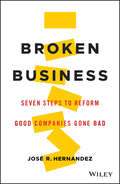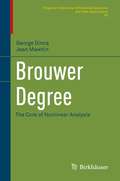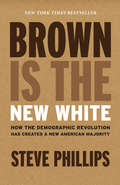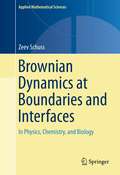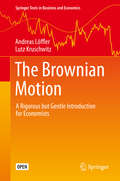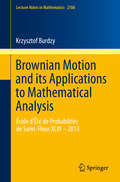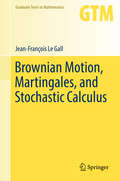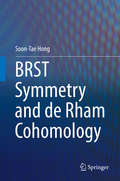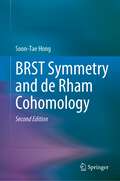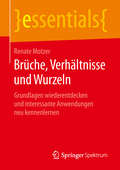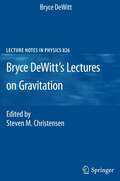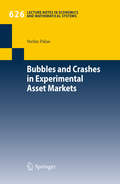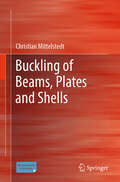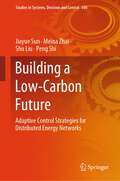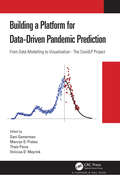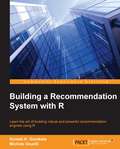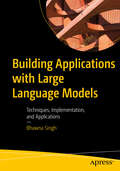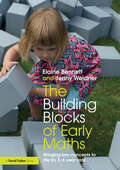- Table View
- List View
Broken Business: Seven Steps to Reform Good Companies Gone Bad
by José R. HernandezHow to prevent corporate scandals and fix good companies that do wrong The news media is replete with stories of corporate scandal, corruption and misdeeds. The need for effective crisis management and corporate governance strategies has never been greater. Broken Business explains why corporate scandals happen, what to do when scandals arise in your company, and how to prevent their future occurrence. Offering real-world anecdotes and solutions, this book details how corporations can mitigate the risk of scandal, reform corporate image and install structures to create a more ethical and profitable company. This insightful resource dispels common misconceptions of corporate misconduct and its causes through fascinating research into human nature, and compelling storytelling that demonstrates fundamental flaws in corporate culture. Author José Hernandez draws on decades of experience working with high-profile global corporations to present seven essential steps for transforming a company, including building a better culture, more effective compliance systems and re-focusing the strategy. This book allows you to: Examine current and highly publicized cases of corporate scandal and their impact on corporate credibility Employ practical methods to rehabilitate your corporation’s public image Implement managerial frameworks to quickly address cases of misconduct Promote a culture of compliance and integrity to encourage good conduct in your corporate environment At its core, this book is a simple, engaging “how to” guide that offers practical advice on institutionalizing integrity in any organization. Broken Business: Seven Steps to Reform Good Companies Gone Bad is an essential text for leaders seeking a concise review at how things can go wrong, how to deal with scandal fallout and how to ultimately become a better company.
Brot und Strom für 10 Milliarden Menschen: Nahrung und Energie für eine wachsende Bevölkerung
by Klaus StierstadtWie lange liefert die Sonne genug Energie für unsere wachsende Bevölkerung?Reichen unsere Dächer aus, um ausreichend Solarstrom zu erzeugen?Stellen Pflanzen und Algen genug Nahrung und Sauerstoff für alle Lebewesen bereit?Millionen Menschen hungern. Strom ist für Milliarden Menschen ein Traum oder zumindest ein Luxusgut. Diese Buch diskutiert mit Hilfe verständlich dargestellter Physik wie weit es zu wenig Ressourcen gibt und wie weit es schlicht eine Problem der Verteilung ist.Das Buch ist gleichermaßen geeignet für Interessierte wie für Personen mit physikalischer Ausbildung. Zahlreiche Vergleiche und Erklärungen zeichnen ein anschauliches Bild, welches durch zahlreiche Abschätzungen und physikalische Details ergänzt wird.
Brouwer Degree: The Core of Nonlinear Analysis (Progress in Nonlinear Differential Equations and Their Applications #95)
by George Dinca Jean MawhinThis monograph explores the concept of the Brouwer degree and its continuing impact on the development of important areas of nonlinear analysis. The authors define the degree using an analytical approach proposed by Heinz in 1959 and further developed by Mawhin in 2004, linking it to the Kronecker index and employing the language of differential forms. The chapters are organized so that they can be approached in various ways depending on the interests of the reader. Unifying this structure is the central role the Brouwer degree plays in nonlinear analysis, which is illustrated with existence, surjectivity, and fixed point theorems for nonlinear mappings. Special attention is paid to the computation of the degree, as well as to the wide array of applications, such as linking, differential and partial differential equations, difference equations, variational and hemivariational inequalities, game theory, and mechanics. Each chapter features bibliographic and historical notes, and the final chapter examines the full history. Brouwer Degree will serve as an authoritative reference on the topic and will be of interest to professional mathematicians, researchers, and graduate students.
Brown Is the New White
by Steve PhillipsDespite the abundant evidence from Obama's victories proving that the U.S. population has fundamentally changed, many progressives and Democrats continue to waste millions of dollars chasing white swing voters. Explosive population growth of people of color in America over the past fifty years has laid the foundation for a New American Majority consisting of progressive people of color (23 percent of all eligible voters) and progressive whites (28 percent of all eligible voters). These two groups make up 51 percent of all eligible voters in America right now, and that majority is growing larger every day. Failing to properly appreciate this reality, progressives are at risk of missing this moment in history-and losing.A leader in national politics for thirty years, Steve Phillips has had a front-row seat to these extraordinary political changes. A civil rights lawyer and a senior fellow at the Center for American Progress, Phillips draws on his extensive political experience to unveil exactly how people of color and progressive whites add up to a new majority, and what this means for U.S. politics and policy. A book brimming with urgency and hope, Brown Is the New White exposes how far behind the curve Democrats are in investing in communities of color-while illuminating a path forward to seize the opportunity created by the demographic revolution
Brownian Dynamics at Boundaries and Interfaces: In Physics, Chemistry, and Biology (Applied Mathematical Sciences #186)
by Zeev SchussBrownian dynamics serve as mathematical models for the diffusive motion of microscopic particles of various shapes in gaseous, liquid, or solid environments. The renewed interest in Brownian dynamics is due primarily to their key role in molecular and cellular biophysics: diffusion of ions and molecules is the driver of all life. Brownian dynamics simulations are the numerical realizations of stochastic differential equations that model the functions of biological micro devices such as protein ionic channels of biological membranes, cardiac myocytes, neuronal synapses, and many more. Stochastic differential equations are ubiquitous models in computational physics, chemistry, biophysics, computer science, communications theory, mathematical finance theory, and many other disciplines. Brownian dynamics simulations of the random motion of particles, be it molecules or stock prices, give rise to mathematical problems that neither the kinetic theory of Maxwell and Boltzmann, nor Einstein's and Langevin's theories of Brownian motion could predict.This book takes the readers on a journey that starts with the rigorous definition of mathematical Brownian motion, and ends with the explicit solution of a series of complex problems that have immediate applications. It is aimed at applied mathematicians, physicists, theoretical chemists, and physiologists who are interested in modeling, analysis, and simulation of micro devices of microbiology. The book contains exercises and worked out examples throughout.
Brownian Models of Performance and Control
by J. Michael HarrisonDirect and to the point, this book from one of the field's leaders covers Brownian motion and stochastic calculus at the graduate level, and illustrates the use of that theory in various application domains, emphasizing business and economics. The mathematical development is narrowly focused and briskly paced, with many concrete calculations and a minimum of abstract notation. The applications discussed include: the role of reflected Brownian motion as a storage model, queuing model, or inventory model; optimal stopping problems for Brownian motion, including the influential McDonald-Siegel investment model; optimal control of Brownian motion via barrier policies, including optimal control of Brownian storage systems; and Brownian models of dynamic inference, also called Brownian learning models, or Brownian filtering models.
The Brownian Motion: A Rigorous but Gentle Introduction for Economists (Springer Texts in Business and Economics)
by Andreas Löffler Lutz KruschwitzThis open access textbook is the first to provide Business and Economics Ph.D. students with a precise and intuitive introduction to the formal backgrounds of modern financial theory. It explains Brownian motion, random processes, measures, and Lebesgue integrals intuitively, but without sacrificing the necessary mathematical formalism, making them accessible for readers with little or no previous knowledge of the field. It also includes mathematical definitions and the hidden stories behind the terms discussing why the theories are presented in specific ways.
Brownian Motion and its Applications to Mathematical Analysis: École d'Été de Probabilités de Saint-Flour XLIII – 2013 (Lecture Notes in Mathematics #2106)
by Krzysztof BurdzyThese lecture notes provide an introduction to the applications of Brownian motion to analysis and more generally, connections between Brownian motion and analysis. Brownian motion is a well-suited model for a wide range of real random phenomena, from chaotic oscillations of microscopic objects, such as flower pollen in water, to stock market fluctuations. It is also a purely abstract mathematical tool which can be used to prove theorems in "deterministic" fields of mathematics. The notes include a brief review of Brownian motion and a section on probabilistic proofs of classical theorems in analysis. The bulk of the notes are devoted to recent (post-1990) applications of stochastic analysis to Neumann eigenfunctions, Neumann heat kernel and the heat equation in time-dependent domains.
Brownian Motion, Martingales, and Stochastic Calculus (Graduate Texts in Mathematics #274)
by Jean-François Le GallThis book offers a rigorous and self-contained presentation of stochastic integration and stochastic calculus within the general framework of continuous semimartingales. The main tools of stochastic calculus, including Itô's formula, the optional stopping theorem and Girsanov's theorem, are treated in detail alongside many illustrative examples. The book also contains an introduction to Markov processes, with applications to solutions of stochastic differential equations and to connections between Brownian motion and partial differential equations. The theory of local times of semimartingales is discussed in the last chapter. Since its invention by Itô, stochastic calculus has proven to be one of the most important techniques of modern probability theory, and has been used in the most recent theoretical advances as well as in applications to other fields such as mathematical finance. Brownian Motion, Martingales, and Stochastic Calculus provides a strong theoretical background to the reader interested in such developments. Beginning graduate or advanced undergraduate students will benefit from this detailed approach to an essential area of probability theory. The emphasis is on concise and efficient presentation, without any concession to mathematical rigor. The material has been taught by the author for several years in graduate courses at two of the most prestigious French universities. The fact that proofs are given with full details makes the book particularly suitable for self-study. The numerous exercises help the reader to get acquainted with the tools of stochastic calculus.
BRST Symmetry and de Rham Cohomology
by Soon-Tae HongThis book provides an advanced introduction to extended theories of quantum field theory and algebraic topology, including Hamiltonian quantization associated with some geometrical constraints, symplectic embedding and Hamilton-Jacobi quantization and Becci-Rouet-Stora-Tyutin (BRST) symmetry, as well as de Rham cohomology. It offers a critical overview of the research in this area and unifies the existing literature, employing a consistent notation. Although the results presented apply in principle to all alternative quantization schemes, special emphasis is placed on the BRST quantization for constrained physical systems and its corresponding de Rham cohomology group structure. These were studied by theoretical physicists from the early 1960s and appeared in attempts to quantize rigorously some physical theories such as solitons and other models subject to geometrical constraints. In particular, phenomenological soliton theories such as Skyrmion and chiral bag models have seen a revival following experimental data from the SAMPLE and HAPPEX Collaborations and these are discussed. The book describes how these model predictions were shown to include rigorous treatments of geometrical constraints because these constraints affect the predictions themselves. The application of the BRST symmetry to the de Rham cohomology contributes to a deep understanding of Hilbert space of constrained physical theories. Aimed at graduate-level students in quantum field theory, the book will also serve as a useful reference for those working in the field. An extensive bibliography guides the reader towards the source literature on particular topics.
BRST Symmetry and de Rham Cohomology
by Soon-Tae HongThis book provides an advanced introduction to extended theories of quantum field theory and algebraic topology, including Hamiltonian quantization associated with some geometrical constraints, symplectic embedding and Hamilton-Jacobi quantization and Becchi-Rouet-Stora-Tyutin (BRST) symmetry, as well as de Rham cohomology. This extended new edition offers a multifaced insight into phenomenology of particles such as baryons and photons, in terms of extended objects. In particular, in the second edition, the baryons are described in hypersphere soliton model, and the photon properties are additionally included in stringy photon model and in Dirac type relativistic quantum mechanics for a photon.It offers a critical overview of the research in this area and unifies the existing literatures, employing a consistent notation. Although the results presented apply in principle to all alternative quantization schemes, special emphasis is placed on the BRST quantization and its de Rham cohomology group which contribute to a deep understanding of constrained physical theories. The book describes how solitons and other models subject to constraints include rigorous treatments of the geometrical constraints which affect the predictions themselves. The book is intended for use by any graduate-level student with quantum field and relativity theories, and it also serves as a useful reference for those working in the field. An extensive bibliography guides the reader toward the source literature on particular topics.
Brüche, Verhältnisse und Wurzeln: Grundlagen wiederentdecken und interessante Anwendungen neu kennenlernen (essentials)
by Renate MotzerRenate Motzer führt in die Welt der Brüche ein und bringt sie in Verbindung mit Dezimalzahlen. Sie zeigt anschaulich, dass Brüche als Anteile eines Ganzen verstanden werden können, aber auch als Verhältnisse von zwei Größen. Die Autorin zeigt verständlich auf, warum Wurzeln nicht exakt durch Brüche angegeben werden können, wie man gute Näherungen findet und warum eine ungewöhnliche Bruchaddition zu paradoxen Ergebnissen führen kann. Weiterhin erläutert sie praxisnah die Anwendung von Brüchen beim Prozentrechnen und in der Wahrscheinlichkeitsrechnung und geht schließlich auf verschiedene Möglichkeiten ein, Mittelwerte zu bilden.
Brückenkurs Mathematik: für Studieneinsteiger aller Disziplinen
by Guido Walz Frank Zeilfelder Thomas RießingerDieses Buch erspart Ihnen die Einstiegsprobleme in die Mathematik, indem es Ihnen auf unterhaltsame Weise eine Brücke baut, die Sie sanft über alle Untiefen hinweg ins Innere der Hochschulmathematik hineingeleitet. Die Brücke beginnt auf der einen Seite beim einfachen Zahlenrechnen, wie es Ihnen vermutlich in der Mittelstufe schon begegnet ist, und führt Sie hinüber bis zu den Grundlagen von Linearer Algebra, Differenzialrechnung und Wahrscheinlichkeitsrechnung, die die Hauptinhalte Ihrer ersten Semester darstellen werden. Diesen Inhalten werden Sie dort immer gegenüber stehen, und bei deren Behandlung können Sie dann beruhigt sagen: "Kenn' ich schon!" Zu jedem Kapitel finden sich Übungsaufgaben, mit deren Hilfe die vermittelten Inhalte eingeübt und vertieft werden können. Neu in die 4. Auflage aufgenommen ist ein Kapitel zur deskriptiven Statistik.
Bruno Touschek 100 Years: Memorial Symposium 2021 (Springer Proceedings in Physics #287)
by Luisa Bonolis Luciano Maiani Giulia PancheriThis open access book celebrates the contribution of Bruno Touschek to theoretical physics and particle colliders in Europe. It contains direct testimonials from his former students, collaborators, and eminent scientists, among them, two Nobel Prize winners in Physics, Giorgio Parisi and Carlo Rubbia. It reviews the main developments in theoretical and accelerator physics in the second half of the twentieth century, while at the same time providing an overview of future prospects worldwide. This book is unique in that it will be of interest to historians of physics and also to the younger generation of researchers. Through the contribution of the leading protagonists, the interested scholar will learn about the past, present status, and relevance of both theoretical and experimental accelerator physics. The overview of Bruno Touschek’s life and works across Europe, from pre-war Vienna to Germany, the UK, Italy, and France, adds a human dimension to the scientific narration, while the open access status makes this laudatory book available to anyone with interest.
Bryce DeWitt's Lectures on Gravitation: Edited by Steven M. Christensen (Lecture Notes in Physics #826)
by Steven M. Christensen Bryce DewittBryce DeWitt, a student of Nobel Laureate Julian Schwinger, was himself one of the towering figures in 20th century physics, particularly renowned for his seminal contributions to quantum field theory, numerical relativity and quantum gravity. In late 1971 DeWitt gave a course on gravitation at Stanford University, leaving almost 400 pages of detailed handwritten notes. Written with clarity and authority, and edited by his former student Steven Christensen, these timeless lecture notes, containing material or expositions not found in any other textbooks, are a gem to be discovered or re-discovered by anyone seriously interested in the study of gravitational physics.
Bubbles and Contagion in Financial Markets, Volume 2: Models and Mathematics
by Eva R. PorrasThis book focuses on extending the models and theories (from a mathematical/statistical point of view) which were introduced in the first volume to a more technical level. Where volume I provided an introduction to the mathematics of bubbles and contagion, volume II digs far more deeply and widely into the modeling aspects.
Bubbles and Crashes in Experimental Asset Markets (Lecture Notes in Economics and Mathematical Systems #626)
by Stefan PalanThis book describes a laboratory experiment designed to test the causes and properties of bubbles in financial markets and explores the question whether it is possible to design markets which avoid such bubbles and crashes. In the experiment, subjects were given the opportunity to trade in a stock market modeled after the seminal work of Smith et al. (1988). To account for the increasing importance of online betting sites, subjects were also allowed to trade in a digital option market. The outcomes shed new light on how subjects form and update their expectations, placing special emphasis on the bounded rationality of investors. Various analytical bubble measures found in the literature are collected, calculated, classified and presented for the first time. The very interesting new bubble measures "Dispersion Ratio", "Overpriced Transactions" and "Underpriced Transactions" are developed, making the book an important step towards the research goal of preventing bubbles and crashes in financial markets.
Buckle Down: Louisiana Mathematics Level 4
by The Editors at the Buckle Down PublishingLouisiana Mathematics Level 4 test prep
Buckling of Beams, Plates and Shells
by Christian MittelstedtThis book contains an introduction to the fundamental principles of the theory of stability of elastic bodies and structures. Beginning with very basic explanations of stability problems, this book starts with the treatment of systems of rigid beams, before beams under normal force and bending as well as the classical field of beam buckling are treated. For the case of beam buckling, an energetic consideration then follows, which forms the basis for a series of approximation methods. In addition to beam buckling, the stability cases of lateral-torsional buckling and lateral buckling are also of fundamental importance, to each of which a separate chapter is dedicated. This is followed by a discussion of plate buckling, and the book concludes with an introduction to shell buckling. This book is aimed at students at technical colleges and universities, as well as engineers in practice and researchers in the engineering sciences.
The BUGS Book: A Practical Introduction to Bayesian Analysis (Chapman & Hall/CRC Texts in Statistical Science)
by David Lunn Chris Jackson Nicky Best Andrew Thomas David SpiegelhalterBayesian statistical methods have become widely used for data analysis and modelling in recent years, and the BUGS software has become the most popular software for Bayesian analysis worldwide. Authored by the team that originally developed this software, The BUGS Book provides a practical introduction to this program and its use. The text presents
Building a Low-Carbon Future: Adaptive Control Strategies for Distributed Energy Networks (Studies in Systems, Decision and Control #506)
by Jiayue Sun Meina Zhai Shu Liu Peng ShiThis book aims to emphasize the state-of-the-art research in realizing the optimal synthesis of microgrid voltage regulation problems using adaptive multi-agent control theory. The contents of this book are divided into four parts. The book describes the microgrid voltage regulation model construction. Building upon this foundation, the book investigates fault-tolerant and event-triggered control problems under different constraints. The effectiveness and applicability of the design methods are verified by simulation arithmetic and applications.The key features of this book are summarized as follows.1) Development of a unified modeling framework for the analysis and design of voltage regulation protocols. 2) Utilization of a novel approach to analyze microgrid secondary control systems, addressing various issues such as event triggering and fault-tolerant control problems. 3) A set of newly developed techniques (e.g., Lyapunov stability theory, LMI techniques) is used to addressemerging voltage regulation challenges.This book is a timely reflection of developments in the new field of integrated theory of voltage regulation and multi-agent system control for microgrids. It serves as a comprehensive collection of the latest research findings, making it a valuable textbook for senior and graduate students who are interested in acquiring knowledge about the following: 1) the latest techniques in microgrid voltage regulation; 2) the latest advances in multi-agent system control; and 3) the latest advances in stability/performance analysis, tracking control, fault-tolerant control, event-triggeredcontrol, and adaptive control. The content of this monograph is divided into six parts. 1) Part one studies the classical problems of microgrid control and multi-agent control. 2) Part two focuses on the event-triggered fault-tolerant voltage restoration problem for islanded microgrids. 3) Part three addresses the fully distributed fault-tolerant secondary event-triggered control of microgrids under directed graphs. 4) Part four examines the output feedback-based fault-tolerant load voltage regulation problem using intermittent communication. 5) Part five presents the secondary load voltage and frequency regulation control based on hierarchical fault-tolerant containment control. 5) Part six investigates the distributed critical bus voltage regulation control problem for multiple microgrids with a positive minimum inter-event time.
Building a Platform for Data-Driven Pandemic Prediction: From Data Modelling to Visualisation - The CovidLP Project
by Dani GamermanThis book is about building platforms for pandemic prediction. It provides an overview of probabilistic prediction for pandemic modeling based on a data-driven approach. It also provides guidance on building platforms with currently available technology using tools such as R, Shiny, and interactive plotting programs. The focus is on the integration of statistics and computing tools rather than on an in-depth analysis of all possibilities on each side. Readers can follow different reading paths through the book, depending on their needs. The book is meant as a basis for further investigation of statistical modelling, implementation tools, monitoring aspects, and software functionalities. Features: A general but parsimonious class of models to perform statistical prediction for epidemics, using a Bayesian approach Implementation of automated routines to obtain daily prediction results How to interactively visualize the model results Strategies for monitoring the performance of the predictions and identifying potential issues in the results Discusses the many decisions required to develop and publish online platforms Supplemented by an R package and its specific functionalities to model epidemic outbreaks The book is geared towards practitioners with an interest in the development and presentation of results in an online platform of statistical analysis of epidemiological data. The primary audience includes applied statisticians, biostatisticians, computer scientists, epidemiologists, and professionals interested in learning more about epidemic modelling in general, including the COVID-19 pandemic, and platform building. The authors are professors at the Statistics Department at Universidade Federal de Minas Gerais. Their research records exhibit contributions applied to a number of areas of Science, including Epidemiology. Their research activities include books published with Chapman and Hall/CRC and papers in high quality journals. They have also been involved with academic management of graduate programs in Statistics and one of them is currently the President of the Brazilian Statistical Association.
Building a Recommendation System with R
by Suresh K. Gorakala Michele UsuelliLearn the art of building robust and powerful recommendation engines using R About This Book * Learn to exploit various data mining techniques * Understand some of the most popular recommendation techniques * This is a step-by-step guide full of real-world examples to help you build and optimize recommendation engines Who This Book Is For If you are a competent developer with some knowledge of machine learning and R, and want to further enhance your skills to build recommendation systems, then this book is for you. What You Will Learn * Get to grips with the most important branches of recommendation * Understand various data processing and data mining techniques * Evaluate and optimize the recommendation algorithms * Prepare and structure the data before building models * Discover different recommender systems along with their implementation in R * Explore various evaluation techniques used in recommender systems * Get to know about recommenderlab, an R package, and understand how to optimize it to build efficient recommendation systems In Detail A recommendation system performs extensive data analysis in order to generate suggestions to its users about what might interest them. R has recently become one of the most popular programming languages for the data analysis. Its structure allows you to interactively explore the data and its modules contain the most cutting-edge techniques thanks to its wide international community. This distinctive feature of the R language makes it a preferred choice for developers who are looking to build recommendation systems. The book will help you understand how to build recommender systems using R. It starts off by explaining the basics of data mining and machine learning. Next, you will be familiarized with how to build and optimize recommender models using R. Following that, you will be given an overview of the most popular recommendation techniques. Finally, you will learn to implement all the concepts you have learned throughout the book to build a recommender system. Style and approach This is a step-by-step guide that will take you through a series of core tasks. Every task is explained in detail with the help of practical examples.
Building Applications with Large Language Models: Techniques, Implementation, and Applications
by Bhawna SinghThis book delves into a broad spectrum of topics, covering the foundational aspects of Large Language Models (LLMs) such as PaLM, LLaMA, BERT, and GPT, among others. The book takes you through the complexities involved in creating and deploying applications based on LLMs, providing you with an in-depth understanding of the model architecture. You will explore techniques such as fine-tuning, prompt engineering, and retrieval augmented generation (RAG). The book also addresses different ways to evaluate LLM outputs and discusses the benefits and limitations of large models. The book focuses on the tools, techniques, and methods essential for developing Large Language Models. It includes hands-on examples and tips to guide you in building applications using the latest technology in Natural Language Processing (NLP). It presents a roadmap to assist you in navigating challenges related to constructing and deploying LLM-based applications. By the end of the book, you will understand LLMs and build applications with use cases that align with emerging business needs and address various problems in the realm of language processing. What You Will Learn Be able to answer the question: What are Large Language Models? Understand techniques such as prompt engineering, fine-tuning, RAG, and vector databases Know the best practices for effective implementation Know the metrics and frameworks essential for evaluating the performance of Large Language Models Who This Book Is For An essential resource for AI-ML developers and enthusiasts eager to acquire practical, hands-on experience in this domain; also applies to individuals seeking a technical understanding of Large Language Models (LLMs) and those aiming to build applications using LLMs
The Building Blocks of Early Maths: Bringing key concepts to life for 3-6 year olds
by Elaine Bennett Jenny WeidnerYoung children need to develop and understand the core basic concepts in mathematics before they can move forward in their mathematical learning. Without these solid foundations, they are more likely to have gaps in their knowledge and require intervention in their primary years. This new book provides guidance and resources to help you develop children’s key skills and understanding in mathematics. Written by experienced teachers, the book outlines key mathematical concepts and provides a wide range of exciting, mathematically rich activities that support the development of these concepts. It exposes some of the common misconceptions and errors that practitioners may observe children showing in their settings and offers simple practical strategies to help move children forward in their thinking and understanding. Covering all areas of mathematics learning – counting and number, calculation, shape and space, pattern, measuring and handling data – the book features: practical ideas for supporting assessment, observation, mathematical vocabulary and building links with home activities that promote a child-led approach, linked to children‘s everyday lives and experiences guidance on how to extend and challenge children’s learning through adult-led, quality teaching and effective practice a clear sense of progression based on children’s understanding rather than age. Written by experienced practitioners, The Building Blocks of Early Maths will help you to ensure that the children in your care have the strong foundations they need to become confident successful mathematician in the future.
